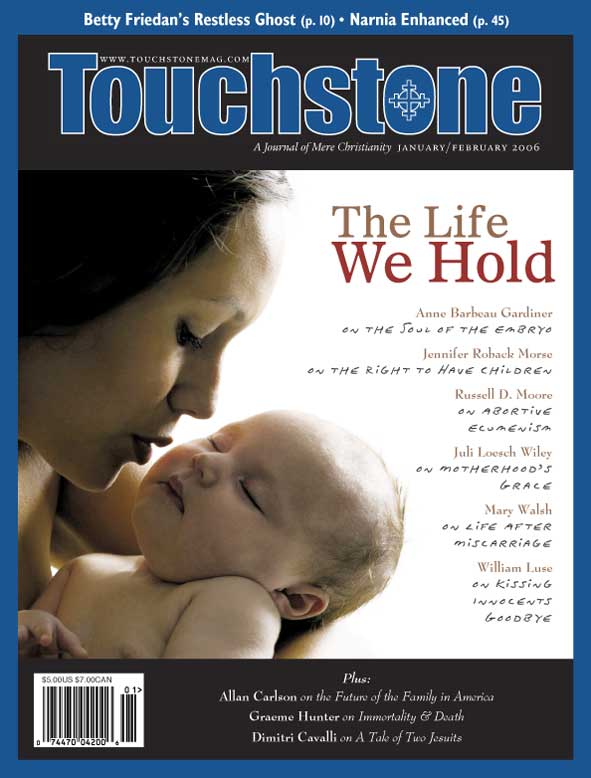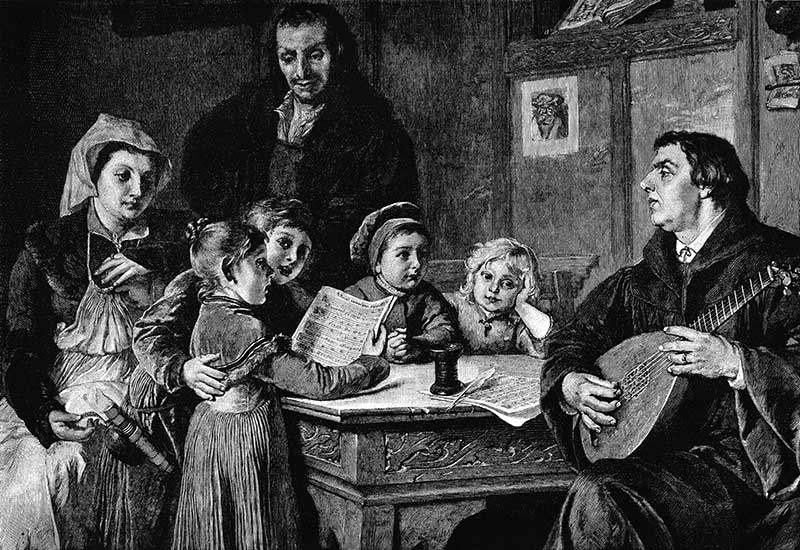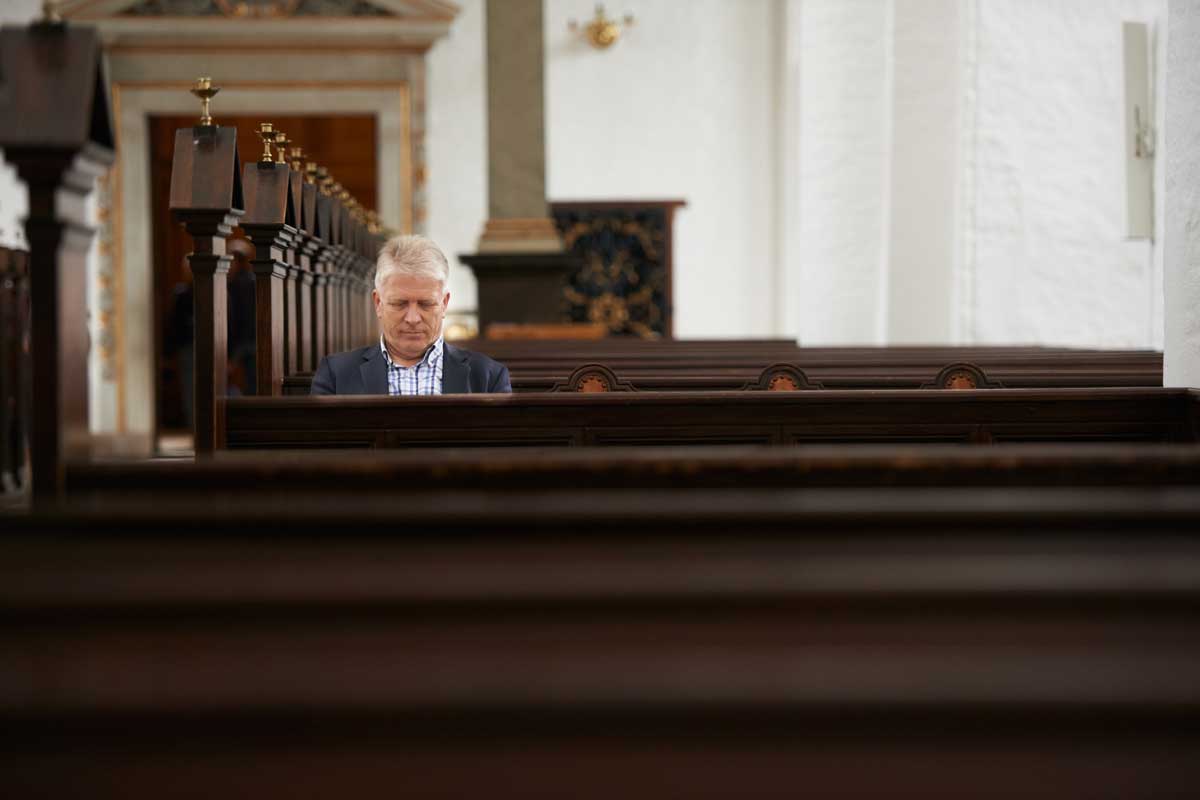The Family Factors
Six Lessons from History About the Future of Marriage & Family in the United States by Allan Carlson
For three decades now, I have tried to explore and explain the historical context for our contemporary “family crisis,” our “war over the family,” our “culture war.” Here I will present what I see as six lessons to be learned from this history, and with an eye to the future.
Permanent Issues
Lesson One: The family issues never change. Or at least they haven’t changed for over two centuries, since the Industrial Revolution began. Take, for example, this peculiar story:
Jack was sitting before the hearth fire, darning his working’s wife’s sock. A tear lay in his eye. ‘No,’ the wretched man said in a thick Yorkshire accent, ‘there is plenty of Wark for Wemen and Bairns [children] in this quarter but very Little for men—thou may as well go try to finde a hondred pounds, as go to find wark abouts heare—but I hed not ment neather thee nor eneyone els to have seen me manding t’wife’s stockings, for it’s a poar job.’
The poor man “wiped away the tear,” the story continues.
‘I do not [k]now what is to become of us,’ he whimpered, ‘for she as been t’man now for a long time, and me t’woman—it is hard wark.’ When he had married, Jack said, he held a fine job and the couple ‘gat on very well—we got a firnished Home. . . . I could wark for us boath. But now t’world is turned upside down. Mary has to turn out to wark and I have to stop at home to mind Bairns—and to Wash and Clean—Bake and mend.’ At that point, Jack lost control and wept violently declaring over and again his wish that he had never been born.
Who wrote this lament about sex roles turned upside down? Was it some early version of Beverly LaHaye? Or perhaps an ancestor of Phyllis Schlafly? No, it was the proto-Communist Friedrich Engels, in his 1844 book, The Condition of the Working Class in England, a powerful indictment of industrial capitalism’s social effects.
Indeed, we can see the non-Marxist labor movement of the nineteenth and early twentieth centuries as seeking, in large part, to rebuild traditional family life within a world torn asunder by the industrial principle, a principle that dictated the radical separation of work and home. The labor movement’s central strategy was to secure a “family wage.” This meant that the industrial sector could have one, but only one, family member: the father.
Pope Leo XIII’s Rerum Novarum in 1891 implied the necessity of a “family wage.” A more forceful articulation came from an American priest, Father John Ryan, in 1916 in a book called Distributive Justice: “The laborer has a right to a family Living Wage because this is the only way in which he can exercise his right to the means of maintaining a family, and he has a right to these means because they are an essential condition of normal life.”
Pope Pius XI directly endorsed the family wage idea in 1931 in Quadragesimo Anno. In a long commentary on this document, the Jesuit author Oswald von Nell-Brenning emphasized the radical consequences of the “family wage”:
It will be absolutely necessary to see to it that female labor is kept from the labor market, something that will have to be attained by prudent and clear-sighted measures. Everyone knows that this cannot be accomplished by decree but requires a far-reaching reconstruction of the entire economic system.
In the United States, at least, a somewhat less rigorous version of this “family wage” economy did exist between 1900 and 1965. It rested in part on public policy (more on that later) and in part on a culturally enforced form of conscious, open job discrimination: the phenomena of so-called men’s jobs (marked by higher wages and salaries and long-term tenure) and women’s jobs (oriented to lower pay and short-term tenure).
However, the revolutionary principle of pure sexual equality, embodied in Title VII of the Civil Rights Act of 1964 and Title IX of the Education Amendments of 1972, shattered this system. The real wages of men fell, and the flow of young mothers into the workforce resumed.
Today, no one in America really talks about the “family wage,” except equity feminist historians who still, with great ritual, regularly dance on its grave. And yet the underlying problems posed by families living in an industrial milieu are still very much with us. There are, for example, muddled campaigns in our day for a “living wage,” although they are marked by intentionally ambiguous normative goals. Does a modern “living wage” assume one or two earners per household? Never a clear answer.
But a true “family wage” would solve, or at least sharply reduce, many of the problems so often complained about today—and so often “solved” by simultaneously accepting the effects of the Industrial Revolution upon family life and asking government to reduce its effects. Contemporary complaints over a lack of quality day care, mounting talk of a “care giving deficit,” the growing “elder care” crisis, so-called work/family conflicts: all derive from the disorders created by the separation of work and home.
Family Partisans
Lesson Two: While the underlying family issues never change, the “pro-family” political party does. The politicization of America’s family crisis did not begin during, say, the late 1960s. It goes back at least one hundred years, to the presidency of Theodore Roosevelt. The scourge of divorce (the Reno divorce mills were up and running by then), the immorality of birth control, the dangers of equity feminism, the peril of shrinking family size and depopulation: all drew Mr. Roosevelt’s frequent and often eloquent commentary between 1900 and 1919.
Roosevelt crafted his own ideology of the hearth, resting on the political and legal equality of women and men and their necessary complementarity in function. Indeed, he equated traditional familism with Americanism: “[I]n all the world there is no better and healthier home life, no finer factory of individual character, nothing more representative of what is best and most characteristic in American life, than that which exists in the higher type of family; and this higher type of family is to be found everywhere among us.”
And yet Roosevelt was nearly unique among early twentieth-century Republican leaders. The dominant spirit in the GOP came from the great bankers, financiers, and manufacturers who made up the corporate-financial wing of the party. Its views on the family were very different. In 1904, the National Association of Manufacturers adopted resolutions designed to subvert the “family wage,” including: “No limitation should be placed upon the opportunities of any person to learn any trade to which he or she may be adapted.”
When equity feminists formed the National Woman’s Party in 1917, they, too, pushed for equal work and equal pay for women outside the home. (There is evidence to suggest that the National Association of Manufacturers secretly funded the party.) When this party drafted its proposed Equal Rights Amendment in 1923, it came as no surprise that the National Association of Manufacturers immediately endorsed it and that Republicans served as its chief sponsors in both the US House and Senate. The Republican party also was the first to endorse the ERA in its Platform.
The common goals of the equity feminists and big business—hostility to the “family wage”; the inclusion of all women, especially young mothers, in the labor market; the commodification of all human activity—made this a strong political alliance. Once the Birth Control League of America cleverly changed its name to Planned Parenthood, it, too, found a compatible home in the GOP; indeed, by the 1950s, Planned Parenthood was a favored charity among Republican women’s clubs.
Maternalist Democrats
The Democrats, meanwhile, consolidated their legacy of “Rum, Romanism, and Rebellion,” that is, their position as the party of cultural pluralism, northern Catholics, Southern agrarians, small property, and the trade unions.
Between 1913 and 1933, moreover, the Democratic party became the favored home of the Social Feminists, or the Maternalists as some now call them: women including Julia Lathrop, Florence Kelley, Frances Perkins, Grace Abbott, Mary Anderson, Frances Kellor, and Molly Dewson. These women believed in equality of rights but difference in function. The first duty of all women, they held, was the defense of home and infant life. And they believed that a career outside the home was incompatible with good mothering.
The Maternalists—backed in all cases by Democratic votes—were responsible for creating the US Children’s Bureau in 1912, for the provision of federal subsidies for homemaking classes for girls in 1917, and for passage of the Sheppard-Towner Act in 1921. This latter measure, the first universal “entitlement” ever approved by Congress, focused on “baby saving”—what a nice description for a federal program—through programs aimed at reducing maternal and infant mortality. Of course, the American Medical Association fiercely opposed Sheppard-Towner, calling it “sob stuff.”
The Democrats’ “New Deal” of the 1930s also represented a triumph for the Maternalists. One current sign of this is the uniform loathing of the New Deal shown by all recent equity feminist historians. Why this reaction? Simply this: Every New Deal domestic program either openly built on or assumed a “family wage” model. The Democrats’ ideal social order was a nation composed of family homes with breadwinning fathers, stay-at-home mothers, and flocks of children. All economic, welfare, and social insurance measures adopted during the 1930s aimed at strengthening this modest patriarchal order.
For example, the largest relief program—the Works Progress Administration—was limited to one breadwinner per family: 85 percent of the 4.5 million enrollees were men. Even those women who were in the program found themselves assigned to “sewing rooms” and to classes in childcare, home health, and cooking. Or consider the Social Security Amendments of 1939, the crown jewel of the New Deal, which gave to working men (but not to working women) new, family-oriented benefits: an extra pension for homemaking wives, and survivors benefits to widows (but not to widowers) and their children.
In short, by 1940, it would be fair to label the Democratic party as the party of the traditional family. The close alliance between ethnic Catholics and the party of Jefferson and Jackson made sense. And this lasted until a fateful day—February 8, 1964—when American political coalitions underwent a seismic shift.
Sexual Upheaval
Under debate was the Civil Rights Act of 1964. The Southern Dixiecrats, with their backs to the wall, turned to a desperate strategy. Howard Smith, Democrat of Virginia, rose and proposed adding “sex” to the list of prohibited discriminations under Title VII, the part of the act dealing with employment issues. It appears that he and his Southern colleagues saw this as a killer amendment, or perhaps as a way to push aside the intended beneficiaries of Title VII—black males—by turning legal attention to the job claims of vastly more numerous white females.
In any case, the equity feminists in the Republican party—including Representatives Katherine St. George of New York and Catherine May of Washington—rallied behind their at times whimsical, at times bewildered, Dixiecrat colleagues. A remarkable debate ensued, where traditional “New Deal” Democrats opposed to the amendment mounted Maternalism’s “last stand.” Emanuel Cellar—liberal Democrat, Manhattanite, Jewish, and chairman of the House Judiciary Committee—defended in this debate the natural inequality of women and men:
You know, the French have a phrase for it when they speak of women and men . . . “vive la difference.” I think the French are right. Imagine the upheaval that would result from the adoption of blanket language requiring total equality. Would male citizens be justified in insisting that women share with them the burdens of compulsory military service? What would become of traditional family relationships? What about alimony?
Prescient questions all. Representative Edith Green, Democrat of Oregon, insisted that the real “biological differences” between men and women needed to be recognized in employment. And so on through this last iteration of the classic Maternalist case in defense of the “family wage.”
In the end, the segregationist Dixiecrats and the Republican equity feminists carried the day on a vote of 166 to 133. As the Civil Rights Act was implemented over the next several years, the Maternalists’ carefully constructed social and legal order entered into crisis . . . and eventual collapse.
Also in 1964, of course, a Catholic wife, mother, and lawyer named Phyllis Schlafly leapt onto the public stage with her book on Barry Goldwater: A Choice, Not an Echo. Over the next sixteen years, she sparked a massive realignment of the political parties. Groups attached to the traditional family, blue-collar Catholics worried about the spread of abortion, and Southern Evangelicals migrated from the Democratic to the Republican party.
Meanwhile, equity feminists and Planned Parent-hood backers largely moved into the Democratic party. The old, morally grounded industrial and trade unions faded away, or were transformed into “public sector” unions logically committed to the equity feminist agenda.
All the same, this new alignment remains unstable. On the Democratic side, wealthy white equity feminists and population-control enthusiasts actually have little in common with the real interests of ethnic minorities. On the Republican side, the Fortune 500 and the autonomous family have sharply conflicting agendas, which no amount of “fusionist” wishful thinking can bridge. The very treatment of social conservatives at 2004’s Republican Convention—locked up out of sight in the party’s attic just like slightly lunatic children—underscores the fragility of this coalition; it is unlikely to last.
Engineered Renewal
Lesson Three: Social engineering can be done the right way, that is, in a way that supports the family and helps it flourish. The first direct federal interventions into elementary and secondary education were the Smith-Lever Extension Act of 1914, which launched the
4-H movement, and the Smith-Hughes Vocational Training Act of 1917, which used federal dollars to pay for home economics teachers.
There were technical sides to these initiatives, but the real spirit of this federal experiment is ably captured by two songs from the Extension Service’s 4-H Songbook of 1928. For boys, “The Plowing Song”:
A growing day in a waking field
And a furrow straight and long,
A golden sun and lifting breeze,
And we follow with a song.
Sons of the soil are we,
Lads of the field and flock.
Turning our sods, asking no odds;
Where is a life so free?
Sons of the soil are we,
Men of the coming years;
Facing the dawn, brain ruling brawn.
Lords of our lands we’ll be.
And for the girls, the song “Dreaming” (here, the third verse):
My home must have its mother,
May I grow sweet and wise;
My home must have its father,
With honor in his eyes;
My home must have its children,
God grant the parents grace—
To keep our home through all the years
A kindly, happy place.
Again, this neo-agrarian, generically Christian, pleasantly patriarchal vision represented federally engineered education in 1928. It is a far cry from the spirit of today’s Title IX. Indeed, it rises out of an alternative moral universe.
This family-building experiment worked, at least for a time. The family farm was not saved, but the ethos of homemaking thrived. In 1945, the US Department of Agriculture created Future Homemakers of America, and this high-school club soon claimed over 600,000 members. As noted earlier, New Deal programs such as Social Security undergirded the breadwinner/homemaker/child-rich family model. So did a string of housing programs, which together mobilized massive capital to provide newly married couples with their own homes.
Tax reforms implemented in the 1940s reinforced marriage and full-time homemaking through the policy of “income splitting” on joint returns. These same tax reforms encouraged larger families through generous per-capita exemptions for children.
The results were striking. For the first time in over a hundred years, three things happened in America at once: The marriage rate rose; the divorce rate fell; and the marital birthrate soared. These were the celebrated “Marriage” and “Baby” Booms of the 1945–1964 era, a time unique in American history. I believe that federal policies favoring the breadwinner/homemaker/child-rich family model helped create the material conditions that made this family renewal possible.
Rise & Fall
Lesson Four: Even Christians have followed the cultural trends to small families. Take the example of American Catholics. From 1900 to 1940, they had behaved increasingly like their Protestant neighbors, at least relative to family formation and fertility. The Protestant and Catholic birthrates in America converged, perhaps a sign of the victory of social and economic pressures over the influence of belief.
At the doctrinal level, though, Protestants and Catholics grew apart. While some Protestant groups—the Anglicans, the old Federal Council of Churches—approved contraception, the Catholic hierarchy labored to shore up orthodoxy on family-related questions. Pius XI issued Casti Connubii in 1930, which reaffirmed historic Catholic teachings: procreation and the rearing of children as the primary purposes of marriage; marriage as an indissoluble sacrament; limitation of family size only for licit reasons; periodic abstinence as the only licit means of birth control; total abstinence from sexual activity as the rule for the unmarried; and the married woman serving in the home as wife and mother.
The large Catholic family received explicit theological affirmation somewhat later. As Pius XII declared: “Large families are most blest by God and specially loved and prized by the Church as its most precious treasures.”
Witnessing, it seems, to this steadfastness in doctrine, the 1945–1964 era produced a “heroic” flowering of Catholic family life in America. Although fertility rose for all American religious groups, it rose far more rapidly and stayed high longer among Catholics. Indeed, there are signs that the American Baby Boom was largely “a Catholic thing.” The total marital fertility rate for non-Catholics averaged 3.15 children born per woman in the early 1950s and 3.14 in the early 1960s. For Catholics, the respective figures were 3.54 and 4.25.
More dramatic was the return of the large Catholic family: In a survey conducted in the early 1950s, only 10 percent of Catholics under age 40 reported having four or more children, a figure very close to the 9 percent for Protestants. By the late 1950s, the Protestant figure was unchanged, but the proportion of Catholics with four or more children had more than doubled, to 22 percent.
Reversed Fertility
Still more surprising was the nature of this postwar resurgence in Catholic fertility. Violating a law of sociology that the more education a woman receives, the fewer children she has, Catholic women who had attended college were bearing more children than Catholic women without a high-school degree. Large families flourished among the best educated. We also find increased fertility primarily among younger parents: Through 1965, each new cohort of parents was more pro-natalist in its attitudes than the group before.
And it had a clear religious focus: More frequent attendance at Mass was related to more births. Indeed, the Catholic family ethic resting on devotion to church teachings seemed to be reaching new highs in the mid-1960s. Among the American laity, at least, there was no apparent crisis of faith.
Within ten years, though, all this had reversed. There seems little doubt that the currents of ideas affecting Catholicism in the mid-1960s—challenges to traditional practices and hierarchical authority during Vatican II, debate on the contraceptive question followed by the stunning reaffirmation of orthodoxy in Humanae Vitae, and the impact of feminist and neo-Malthusian ideas on key Catholic elites—lay behind the collapse. Dissent gained some legitimacy. It appears that the laity may simply have followed the easiest of several disputed paths of obedience.
Indeed, changes in lay Catholic attitudes and behavior can be traced to the specific years 1967–1971. One study of Catholic fertility in Rhode Island found that the average expected family size among Catholics fell from 3.3 children to 2.8 during those four years, a substantially greater decline than that among Protestants. This fall in expected fertility was sharpest for the better educated: from 3.7 to 2.7 children among Catholic women with some college education.
Frequency of attendance at Mass no longer proved to be related to fertility. Even the large-family ideal vanished: In 1967, 28 percent of “devout” Catholics planned to have five or more children, but by 1971, only 6 percent did.
Unnatural Sterility
Lesson Five: Fertility reflects belief, and religious belief benefits society by raising it. One book disorienting American families during the late 1960s was The Population Bomb, Paul Ehrlich’s notorious case for radical measures aimed at population control. It proved mistaken, but not until it had helped convince millions of Americans to limit the size of their families and provide contraceptive devices to all who wanted them.
While the American Baby Boom and falling mortality rates in the Developing World could then be used to project frightening scenarios of a globe swarming with over 50 billion people, it is now clear that falling human fertility has been the real long-term story, and poses the real danger. In 2004, 80 nations recorded below-replacement, or negative-growth, fertility. The global population, it appears, should peak in 2050 at a little over 8 billion souls, and decline thereafter as nation after nation falls into the “age trap” described in Phillip Longman’s recent book, Empty Cradle: too few children to sustain the elderly. (And this is only one of the negative effects of declining, and therefore aging, population.)
In other words, far from being a danger to the planet, human fertility preserves the future. (And this is not its only benefit.) What caused this radical shift? There actually appear to be two distinct fertility transitions. The first one accounts for a shift from a “natural” level of fertility, seven to nine children born per couple, down to the replacement level of two.
The best explanation for the first transition, I believe, comes from the Australian demographic historian, John Caldwell, in his book Theory of Fertility Decline. Looking at the Western world, Caldwell attributes part of the decline to a “spectacular growth in capitalist” production and gadgets that overwhelmed residual home production, and part to Europe’s egalitarian streak, a legacy of the French Revolution. Yet the real spoiler, he insists, was mass state education, which indoctrinated new generations against the old family morality rooted in Christian faith.
The new government schools, introduced in the nineteenth century, did not only reduce the potential for child labor around the house and raise the cost of items such as children’s clothing, making children less useful and more expensive. They also became, for the children involved, the new focus of loyalty and advocate for the future, displacing the family. As Caldwell shows, the schools “made citizens of those whose horizons had been largely confined to the family, and taught the immorality of putting family first.” State schools so “destroy[ed] the corporate identity of the family,” attacking parental authority in particular, that fertility tumbled.
What was true for Europe and America soon became true for the whole world. As Caldwell concludes: “It seems improbable—and has yet to be demonstrated—that any society can sustain stable high fertility beyond two generations of mass schooling.”
Testing this theory in the United States, researchers found the spread of state schooling to be closely related to fertility decline in the nineteenth and early twentieth centuries. Indeed, even in rural school districts, each additional month of a public school year resulted in an average fertility decline of .23 children: The state schools consumed children.
The Natural Floor
The second fertility transition is from a replacement level of two children per couple down to .85 of a child, which one European analyst considers the natural “floor” of fertility. What might be the cause here?
A Belgian demographer has shown that only 20 percent of all citizens of the European Community above age 18 have some link to organized religion. Among young adults alone (the people most likely to have children), the figure is closer to 10 percent. Recent changes in family formation and marital fertility, he argues, merely continue the “long-term shift in the Western ideational system” away from the values affirmed by Christian teaching (specifically “responsibility, sacrifice, altruism, and sanctity of long-term commitments”) and toward a militant “secular individualism” focused on the self.
Low fertility is a sign of what an American scholar, Ronald Inglehart, has called “the silent revolution” in European values starting in 1964. Scholars have noted that remaining pockets of high fertility in Europe—such as in the rural regions of Switzerland and the pockets of higher “Catholic fertility” still to be found in Spain and Portugal—all disappeared after 1964. In contrast, 97 percent of 21-year-old Danish women now report having had pre-marital sex, essentially marking the full collapse there of the old sexual ethic.
Can the Europeans turn their situation around? It is highly unlikely. To begin with, the “momentum” of demographic change in Europe shifted to the negative side in the year 2000. The very age structure of the population now makes fertility decline much more likely than during the prior four decades, when it was already sharp and sustained.
Moreover, most European policymakers are simply clueless regarding the driving roles of statism and secularism in the changes they now confront. They commonly embrace materialistic explanations of cause, welcome the disappearance of motherhood as a vocation, dismiss the Christian religion as a superstition of the past, and place all their hopes in the Swedish model. Specifically, they call for full sexual equality and the priority of the work life over the family, and, to support the family thus created, call for generous day care, paid parental leave, child allowances, and other welfare benefits. However, such reforms actually lock post-family, anti-child values into place.
Growing Americans
Lesson Six: American exceptionalism is real and social creativity remains possible here. Europe is dying. So is Japan, also being done in by a broad rejection of children. However, unlike forty years ago, when America was leading the global retreat from marriage and children, something different is now happening here. The United States is the only developed nation in the world that recorded an increase in its total fertility rate between 1981 and 2000: from 1.81 in 1981 to 2.13 in 2000, an increase of 18 percent, to a point slightly above the replacement or zero-growth level.
This was not, as some suggest, only a function of a rising number of births out-of-wedlock. Between 1995 and 2000, even marital fertility rose by 11 percent, the first sustained increase in that number since the mid-1950s. Nor was this a function of America’s greater ethnic diversity. Fertility among Americans of European descent actually climbed by 21 percent after 1981, to a total fertility rate of 2.114 in 2000.
As The Economist magazine summarized, “Demographic forces are pulling America and Europe apart. . . . America’s fertility rate is rising; Europe’s is falling. America’s immigration outstrips Europe’s. . . . America’s population will soon be getting younger. Europe’s is aging.” The magazine predicts a US population of up to 500 million by 2050, compared to a Europe in demographic freefall, with barely half as many people.
The best explanation for America’s greater fecundity—this openness to children—is the higher degree of religious identification and behavior shown by Americans. Forty-five percent of Americans in the year 2000 reported attending religious services during the previous week; in Europe, only about ten percent did. And believers usually do have more babies. Alas, outside of recent Hispanic immigrants, overall Catholic numbers today are not impressive, but “white fundamentalist Protestants” who attend church weekly show a fertility rate 27 percent above the national average, and the fertility rate of active American Latter-Day Saints, or Mormons, is about double the national average.
America’s resilience can also be seen in that most unexpected, but successful, American folk movement of the last thirty years: homeschooling. Probably numbering fewer than 20,000 children in 1975, there are about two million home-educated children in America today: a hundred-fold increase. The last fifteen years have witnessed a surge in the number of Catholic families so engaged. And fertility is affected as well.
As John Caldwell argued, state-run mass schooling drives fertility down. As would be predicted, homeschooling families drive it up. Sixty-two percent of home-educated children come from families with three or more children, compared to 20 percent of non-homeschoolers. Over 33 percent of homeschooling families have four or more children, compared to but 6 percent of those in state and private schools.
History’s Lessons
And so, I offer you again my six lessons from history: (1) The family issues never change, or haven’t in a very long time, because they reflect a situation that has not changed; (2) the identity of the “pro-family” political party does change, and has; (3) “social engineering” can be done the right way, by supporting the breadwinner/homemaker/child-rich model of the family; (4) even Christians have followed the cultural trend to small families; (5) nevertheless, fertility reflects belief, and religious belief benefits society by raising it; and (6) America is an exception to the pattern in the rest of the West, and that should give us hope.
"The Family Factors" is adapted from a paper given at the annual meeting of the Fellowship of Catholic Scholars (www.catholicscholars.org).
Allan C. Carlson is the John Howard Distinguished Senior Fellow at the International Organization for the Family. His most recent book is Family Cycles: Strength, Decline & Renewal in American Domestic Life, 1630-2000 (Transaction, 2016). He and his wife have four grown children and nine grandchildren. A "cradle Lutheran," he worships in a congregation of the Lutheran Church-Missouri Synod. He is a senior editor for Touchstone.
subscription options
Order
Print/Online Subscription

Get six issues (one year) of Touchstone PLUS full online access including pdf downloads for only $39.95. That's only $3.34 per month!
Order
Online Only
Subscription

Get a one-year full-access subscription to the Touchstone online archives for only $19.95. That's only $1.66 per month!
bulk subscriptions
Order Touchstone subscriptions in bulk and save $10 per sub! Each subscription includes 6 issues of Touchstone plus full online access to touchstonemag.com—including archives, videos, and pdf downloads of recent issues for only $29.95 each! Great for churches or study groups.
Transactions will be processed on a secure server.
more on family from the online archives
more from the online archives
calling all readers
Please Donate
"There are magazines worth reading but few worth saving . . . Touchstone is just such a magazine."
—Alice von Hildebrand
"Here we do not concede one square millimeter of territory to falsehood, folly, contemporary sentimentality, or fashion. We speak the truth, and let God be our judge. . . . Touchstone is the one committedly Christian conservative journal."
—Anthony Esolen, Touchstone senior editor













